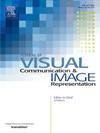A multi-exposure image fusion using adaptive color dissimilarity and dynamic equalization techniques
IF 2.6
4区 计算机科学
Q2 COMPUTER SCIENCE, INFORMATION SYSTEMS
Journal of Visual Communication and Image Representation
Pub Date : 2024-11-28
DOI:10.1016/j.jvcir.2024.104350
引用次数: 0
Abstract
In the domain of image processing, Multi-Exposure Image Fusion (MEF) emerges as a crucial technique for developing high dynamic range (HDR) representations from fusing sequences of low dynamic range images. Conventional fusion methods often suffer from shortcomings such as detail loss, edge artifacts, and color inconsistencies, thereby compromising the quality of the fused output which is further diminished with extremely exposed and limited inputs. While there have been a few efforts to conduct fusion on limited and impaired static input images, there has been no exploration into the fusion of dynamic image sets. This paper proposes an effective MEF approach that operates on a minimum of two extremely exposed, limited datasets of both static and dynamic scenes. The approach initiates with categorizing input images into under-exposed and over-exposed categories based on lighting levels, subsequently applying tailored exposure correction strategies. Through iterative refinement and selection of optimally exposed variant, we construct an advanced intermediate stack, upon which fusion is performed by a pyramidal fusion technique. The method relies on adaptive well-exposedness and color gradient to develop weight maps for pyramidal fusion. The initial weights are refined using a Gaussian filter and this results in the creation of a seamlessly fused image with expanded dynamic range. Additionally, for dynamic imagery, we propose an adaptive color dissimilarity and dynamic equalization to reduce ghosting artifacts. Comparative assessments against existing methodologies, both visually and empirically confirms the superior performance of the proposed model.
基于自适应色彩不相似度和动态均衡技术的多曝光图像融合
在图像处理领域,多曝光图像融合(MEF)是一种从低动态范围图像融合序列中提取高动态范围图像的关键技术。传统的融合方法通常存在细节丢失、边缘伪影和颜色不一致等缺点,从而影响了融合输出的质量,在极度暴露和有限的输入下,融合输出的质量进一步降低。虽然对有限和受损静态输入图像进行融合的研究很少,但对动态图像集的融合还没有探索。本文提出了一种有效的MEF方法,该方法可以在静态和动态场景的至少两个极度暴露的有限数据集上运行。该方法首先根据光照水平将输入图像分为曝光不足和曝光过度两类,随后应用量身定制的曝光校正策略。通过迭代优化和选择最优暴露变量,构建了一个先进的中间堆栈,在此基础上采用金字塔融合技术进行融合。该方法依靠自适应的良好曝光和颜色梯度来建立金字塔融合的权重图。初始权重使用高斯滤波器进行细化,从而创建具有扩展动态范围的无缝融合图像。此外,对于动态图像,我们提出了自适应色彩不相似和动态均衡来减少重影伪影。对现有方法的比较评估,无论是视觉上还是经验上,都证实了所提出模型的优越性能。
本文章由计算机程序翻译,如有差异,请以英文原文为准。
求助全文
约1分钟内获得全文
求助全文
来源期刊

Journal of Visual Communication and Image Representation
工程技术-计算机:软件工程
CiteScore
5.40
自引率
11.50%
发文量
188
审稿时长
9.9 months
期刊介绍:
The Journal of Visual Communication and Image Representation publishes papers on state-of-the-art visual communication and image representation, with emphasis on novel technologies and theoretical work in this multidisciplinary area of pure and applied research. The field of visual communication and image representation is considered in its broadest sense and covers both digital and analog aspects as well as processing and communication in biological visual systems.
 求助内容:
求助内容: 应助结果提醒方式:
应助结果提醒方式:


